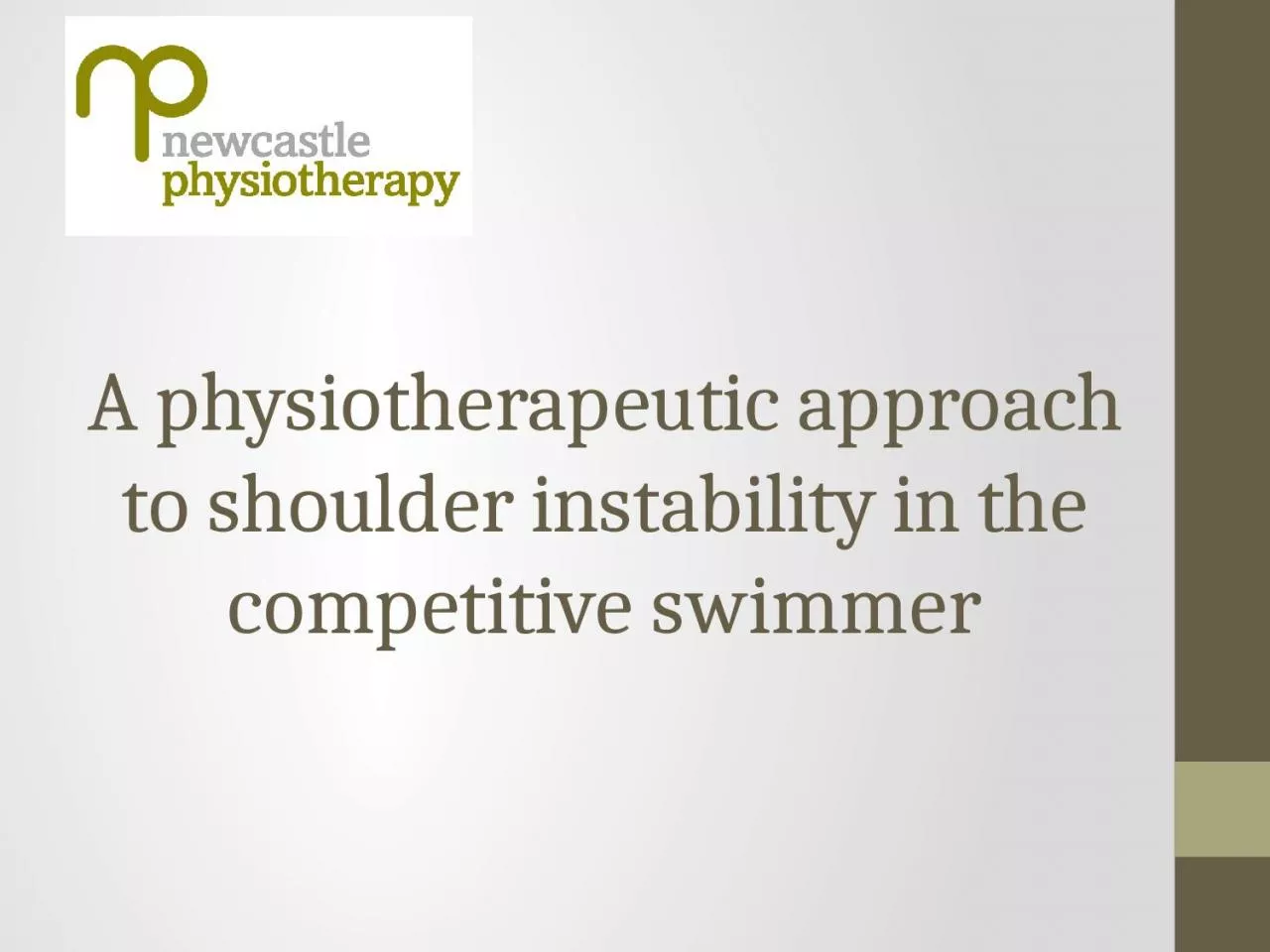

Sports Physiotherapist specialising in swimming Founder and practice principal physiotherapist Newcastle Physiotherapy Former Senior GB International swimmer and British record holder for 200 and 400 IM ID: 933658
Download Presentation The PPT/PDF document "A physiotherapeutic approach to shoulder..." is the property of its rightful owner. Permission is granted to download and print the materials on this web site for personal, non-commercial use only, and to display it on your personal computer provided you do not modify the materials and that you retain all copyright notices contained in the materials. By downloading content from our website, you accept the terms of this agreement.
Slide1
A physiotherapeutic approach to shoulder instability in the competitive swimmer
Slide2Sports Physiotherapist specialising in swimming
Founder and practice principal physiotherapist, Newcastle Physiotherapy
Former Senior GB International swimmer and British record holder for 200 and 400 I.M
Member of the GB Swimming Physiotherapy team, London 2012 Olympic Games
Darren
Wigg, Bsc (Hons) MCSPSM, HCPC Reg.
Introduction
Slide3What is shoulder instability?
Inability to maintain HOH in glenoid
Can occur anteriorly (
est
98%), posteriorly or multidirectionallyAtraumatic instability occurs from repetitive overload or congenital joint featuresFocus today on atraumatic overload through swimming
Slide4Ball and socket joint
Head of
humerus
and Glenoid
Very small shallow glenoid – ‘golf ball on a tee’
Inherently unstableNecessary for huge multi-directional ROM required
Anatomy
Slide5Static stability
Superior Glenohumeral
Ligament
Limits anterior and inferior translation of adducted humerusMedial Gleonohumeral LigamentLimits anterior translation in lower and middle range of abductionInferior Glenohumeral LigamentPrimary
static restraint against anterior and posterior and inferiortranslation when humerus is abducted beyond 45
degreesGlenoid LabrumIncreases depth of glenoid cavity and increases stability up to 50%Negative intra-articular pressureAssists in maximizing joint congruency.
Slide6Dynamic stability
Dynamic stability is provided by the rotator
cuff
Innervated by C5-6
Originate from the scapularAll have a different function………
Slide7Dynamic stability
Supraspinatus initiates abduction and continues through range with deltoid
Infraspinatus laterally rotates primarily with arm in neutral
Teres Minor laterally rotates and is more active when arm is in 90 degrees of abductionSubscapularis internally rotates, strongest rc muscle providing 53% of total cuff strength
Slide8Mobilisers
Slide9Mobility demands
Slide10Mobility demands
Slide11Swimming shoulders
Abnormally high number of shoulder rotations per arm, per year
How many…..
Slide12………..1.32 million!!
Slide13Swimming shoulders
Shoulder instability and joint
hypermobility
common in elite
level swimmers – why???Swimmer screening results show hypermobile = better swimmersBeighton’s Score - higherAppears to be advantage for the competitive swimmerInstability
can lead to shoulder pain and pathologySubtle
balance required between mobility, strength and motor control
Slide14Presentation, common subjective findings
Constant/intermittent pain, deep ache
Often report
cluncking
or clickingOften insideous onsetAggravating activities: catch and recovery phase of FC,BF and BC, lying on it, overhead activitiesEasing activities: support, avoidance of aggs, NSAID’S, iceActivity dependent rather than diurnal patternOften report recent change in training load/type - overload
Slide15Posture
Swimming predominantly uses the anterior muscles at the front of the shoulder and chest
This can cause those muscles to become overactive and short pulling the shoulder forwards. The muscles at the back become underactive, weak and long
Kyphotic thoracic spine, protracted shoulder girdle and anteriorly translated HOH can narrow sub-acromial space and predispose swimmers to pain
Slide16Presentation, Common objective tests/findings
Scapula winging or
dyskinesis
Painful arc of elevation
Positive RC tests and resisted testsPositive instability tests…..
Slide17Load and Shift test
One hand stabilising over acromion
Other hand gripping HOH
Compress and glide anteriorly and posteriorly
Grade laxity 1-3
Slide18Apprehension Relocation
Anterior instability
Shoulder at 90 abduction
Take to full passive LR
Apprehension positive if pain and or apprehensionRepeat with AP force through HOHIf pain free – test positive
Slide19Sulcus sign
Superior
glenohumeral
ligament
Multidirectional instabilityOne hand on acromianOther hand gripping shaft of humerus above the elbow
Positive if sulcus appears below acromian
of 2cm or above
Slide20Hypermobility assessment
Beightons
Score for hypermobility
Score above 4
Research suggests 10% of populationReduced levels of collagen in connective tissue
Slide21Beightons Score
Hypermobility
Slide22Secondary problems
Shoulder instability
can
predispose the swimmer to shoulder pain due to:Rotator cuff impingement, tears or tendonopathiesSub-acromial bursitis
Labral tears
Shoulder laxity per se minimal association with impingement (Lay Sein et al 2009)
Slide23Typical treatment plan
Advice and education
surrounding acute pain management and adaption of training - coach
Supportive tape
Manual therapy:Mobilisation of stiff joints (usually cervicothoracic region)Mobilisation of overactive muscles (usually posterior cuff and subscapularis, pecs, upper trapezius)Exercise therapy:Initially low level scapular stability and control, progressing to more complex sport specific workRotator cuff conditioning with good scapular control, progressing through larger ROM as ableProgressive upper limb weight bearing exercise to stimulate stability muscles Stretching and foam roller/ trigger point ball for tight overactive mobilisers………
Slide24Stroke / program analysis
Stroke analysis and attentive coaching will help to avoid the common mistakes which contribute to shoulder
pain
The
common faults in technique that reduce efficiency also increase risk of injuryPoor frontcrawl technique can predispose a swimmer to shoulder painInsufficient trunk rotation with a pull that crosses the mid line of the body is the main causative factorPoor core stability in the water can also contribute to the problemManage training loads ? Most important – most often asked why now?
Slide25Delicate balance
We can’t strengthen ligaments without surgery!
We must strengthen the rotator cuff and scapular musculature to compensate for ligamentous laxity
Reduce muscle imbalances
Work on improving motor control and upper limb proprioceptionImprove spinal and shoulder girdle postureImprove technical deficienciesManage training loads
Slide26Conclusions:
These data indicate: (1) supraspinatus tendinopathy is the major cause of shoulder pain in elite swimmers; (2) this tendinopathy is induced by large amounts of swimming training; and (3) shoulder laxity per se has only a minimal association with shoulder impingement in elite swimmers.
Br J Sports Med
doi:10.1136/bjsm.2008.047282
Shoulder Pain in Elite Swimmers: Primarily Due to Swim-volume-induced Supraspinatus TendinopathyMya Lay Sein (mlsein@gmail.com)Orthopaedic Research Institute, AustraliaJudie Walton (j.walton@unsw.edu.au)Orthopaedic Research Institute, AustraliaJames Linklater
(linklj@telstra.com)Castlereagh Imaging, AustraliaRichard AppleyardOrthopaedic Research Institute, Australia
Brent KirkbrideNew South Wales Institute of Sport, AustraliaDonald KuahNew South Wales Institute of Sport, AustraliaGeorge AC Murrell (murrell.g@ori.org.au)
Slide27refs
Hayes K, Callanan M, Walton J. Shoulder instability: Management and rehabilitation. JOSPT 2002;23(10):497-509.